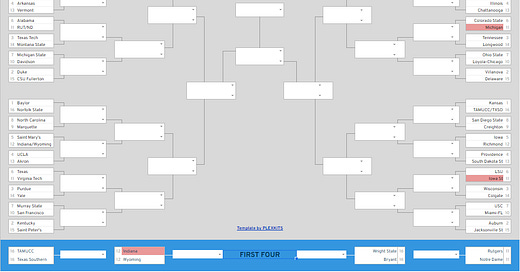Ret and I were thinking - dangerous, we know - but still. We put our heads together, and came up with two rules to make for a better NCAA Tournament bracket, one fairer and more representative of the college basketball landscape.
They’re as follows:
A team must be over .500 in conference play (the NCAAT already mandates that all at-large selections must be over .500 anyways, but does not hold that restriction to conference play).
A team must also finish in the top half of its conference. If there are an odd number of teams, round DOWN. The Big East, for example, with 11 teams - the maximum number of bids they can send is 5.
Our goal is to increase representation, spread the wealth to smaller conferences, and showcase what teams who had limited opportunities during the regular season can do when presented with said opportunities - as opposed to giving teams like Syracuse or Oklahoma with their innate ability to go 17-13 every year a bid.
We decided, now that the 2022 bracket is out, to apply that logic to the 2022 field to see who would line up instead - who gets forced out, who has an opportunity to sneak in, and how that may make things look different.
Based on our criteria, the following teams would be excluded from the field:
Seton Hall - 8 seed, South Region. The Pirates are the sixth Big East team to receive a bid, and as such, fall past the “half a conference” cut-line.
TCU - 9 seed, South Region. The Horned Frogs are under .500 in the Big 12, and as such, are eliminated from contention.
Iowa State - 11 seed, Midwest Region. The Cyclones are under .500 in the Big 12 and fall outside the half-conference limit.
Michigan - 11 seed, South Region. The Wolverines fall outside the half-conference limit by virtue of placing 8th in the Big Ten.
Indiana - 12 seed, East Region. The Hoosiers, sub-.500 in conference and outside the half-conference limit for the Big Ten, would be the fifth and final team excluded from the tournament.
To replace them, we followed the committee’s rules, and ran down the list of NIT teams in seeding order to see who would fill the gaps that the five teams cut out by our rulings have left. That went as follows:
Dayton - the third A-10 team in the field, the Flyers were above the .500 limit and well inside the top half of the conference limit of 7. Welcome to the Dance!
Oklahoma - the Sooners did not make it to .500 in conference, nor did they fall inside the top half of the Big 12. They’re not getting a bid.
SMU - the American Conference only sent two teams in Houston and Memphis, so the Mustangs are good on that front, and as they finished above .500 in conference, they’re qualified. Welcome!
Texas A&M - arguably the most notable snub, especially after Buzz Williams pled his case to reporters after their NIT win against Alcorn last night, the Aggies unfortunately placed 8th in a SEC that would only qualify a maximum of 7 teams per our rules. Tough.
Wake Forest - a down ACC that would normally fill well more than their allotment of 7 per our ruleset only landed five teams in the tournament. Up and at ‘em, Deacs, you’re going dancing.
BYU - the 4-bid WCC dream survives! Though the Cougars fell to the NIT in the actual bracket, in our world, they’d leap in by virtue of a over-.500 record in conference and the WCC only sending three teams to this point. Praise be!
North Texas - a team that was a longshot for an at-large before a miserable conference tournament loss, the Mean Green find themselves our Last Team In under these rules.
There you have it! The purpose of this exercise was to see whether our system - devised to be a fairer methodology, offering better opportunities to more teams from a wider range of deserving conferences, would be a system that 1) worked and 2) had merit in implementation.
That’s up to y’all, though. Sound off! What do you think?






What about Xavier? How did they miss out?